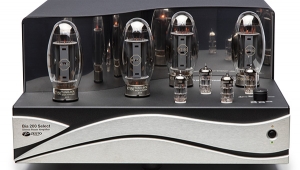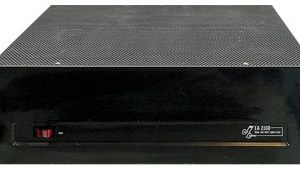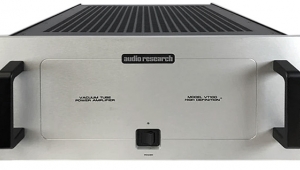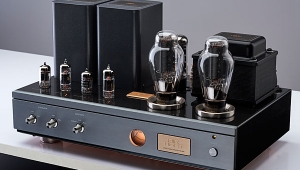| Columns Retired Columns & Blogs |
Audio Research VS110 power amplifier & SP16L line preamplifier
For those who frequent the audio discussion groups on the Internet, the method by which Stereophile selects products for review seems to be a continuing source of fascination and conjecture. Supporters of fledgling manufacturers—whose products these Webcrawlers just happen to own—rail against the rule that products to be reviewed in the magazine must have at least five US dealers. Some suggest that Stereophile's selection of review products is all about catering to advertisers and friends in the industry, a process that seems intended to exclude their favorite products from consideration.
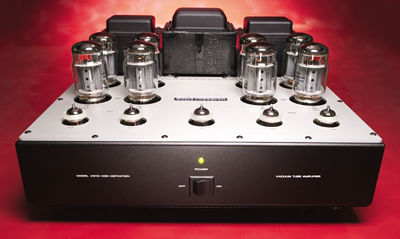
In fact, selecting products for review is not all that different from what any audiophile goes through in selecting products for audition and possible purchase. For me to consider reviewing a product, I have to feel that it has the potential of sounding good and that Stereophile readers would be interested in hearing about it. As part of the selection process, I talk to people in the industry and audiophiles, look at ads (in Stereophile and elsewhere), check out the Internet buzz, and even read other magazines to see if there's something interesting that I've missed. Once I've identified a new product that I think would be worth spending some time with, I check with editor John Atkinson about the appropriateness of the choice, and, contingent on his approval, contact the manufacturer to see if they will provide a review sample.
I became aware of the existence of the Audio Research VS110 and SP16L when, during a recent vacation in France, I picked up an issue of Revue du Son et du Home Cinéma that had a review of the VS55, the other amplifier in Audio Research's new line. My French is not good enough to understand all the fine nuances of expression, but the review was obviously a very positive one. There was also reference to a favorable review of the SP16 (the line-plus-phono version of the SP16L) in the previous issue of the magazine.
My plan was to review the VS55. JA approved the project, but Terry Dorn, Audio Research's VP for Sales and Marketing, suggested that I review the VS110, which has the same topology but with more power and, according to him, even better sound, and which had not yet been reviewed. I liked the bit about "even better sound," but had some concerns that this amplifier's 100Wpc might not be the best match for my +100dB-sensitive Avantgarde Uno 3.0 speakers. However, Dorn assured me that the VS110's noise level was low enough not to be a problem, and that one of their dealers also sells Avantgardes and has reported no compatibility problems with either amplifier. While I was at it, I thought I might as well review the SP16L, the preamp designed to mate with the VS55 and VS110.
Description and Design
VS110: If you were to ask the average audiophile to describe what a "tube amplifier" looks like, I suspect the answer would pretty much fit the Audio Research VS110. There's a chassis of generous proportions, with the eight 6550EH output tubes given plenty of room for ventilation. There are three transformers (one for power, one per channel for output) of very substantial weight, proprietary units built to AR's specifications. The output tubes are made by Electro Harmonix, the "elite" division of Sovtek, and come as four matched pairs. The five 6N1P input/driver tubes are partially recessed into the chassis, and have ARC damper rings on them.
The VS110 comes without a chassis cover, which is just the way I like it, but people with overly inquisitive small children and pets may want to order the $250 perforated cover and mounting hardware. The chassis has small slots for inserting the supplied plastic alignment tool, which can be used to adjust each output tube's bias. The measurement points are banana jacks at the rear of the amp. The bias is a nominal 65mA, which represents conservative operation. Following the recommended 20-minute warmup period, I checked the test voltages with a digital voltmeter and found that they were all within about 5% of the specified 65mV DC. I waited another hour or so, then adjusted the bias potentiometers to bring the voltages even closer to spec.
The power switch is conveniently located front-and-center (no reaching behind); the chassis rear has RCA input jacks (no XLRs), three pairs of 5-way binding posts (marked 0-4-8 ohm), an IEC AC socket, and two 12VDC remote-control jacks. The amp's four feet are oversized and more compliant than the norm. The VS110's fit'n'finish suggest a high-quality product assembled with care and precision.
According to Terry Dorn, the VS110 uses a straightforward push-pull triode input/driver feeding a partial-cathode-coupled output stage of the type used in AR's classic D115 and D250 amplifiers, updated with the best in contemporary high-quality components. One significant difference between the VS110 and earlier AR designs is that this one uses many smaller, faster, high-purity Nichicon capacitors rather than the larger single capacitors used in the older designs. Unlike the amplifiers in AR's VT and Reference series, the VS110 is single-ended rather than balanced in operation. (Some people, like my esteemed colleague Martin Colloms, might consider this an advantage.)
- Log in or register to post comments
